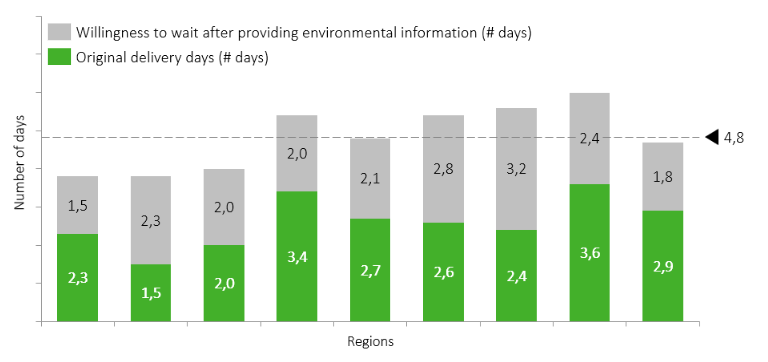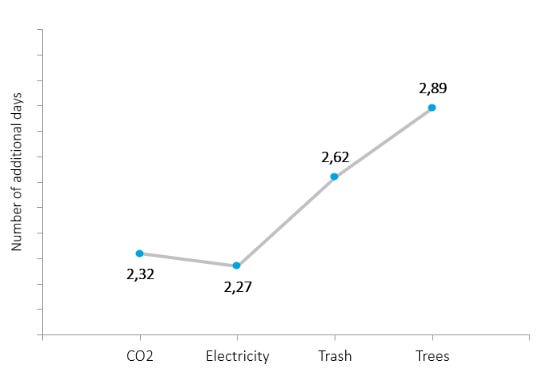The Green Button Project: how consumers can drive sustainable supply chains
Issue #1 - Shifting customer value in favour of sustainability through transparent information and effective communication
Key take-aways:
E-commerce has revolutionized the market, but it poses a significant challenge for the sustainable supply chain
Consumers play a crucial role in sustainable supply chains, particularly in green logistics
When consumers are made aware of the environmental consequences of their actions on the supply chain, a considerable number are willing to cooperate with companies
Altering customer value by presenting the environmental impact in terms of trees can make a consumer-facing logistics and consolidation strategy feasible
How E-commerce is hindering sustainable supply chain progression
In today's digital age, virtually any product can be ordered at the click of a button. E-commerce has undeniably revolutionised the market, rendering the traditional brick-and-mortar business model increasingly obsolete. It seems every company now operates either purely online or as a hybrid of the two. However, this shift necessitates a complete overhaul of the logistics system and supply chain, a task that becomes increasingly challenging as consumers demand faster and more convenient delivery options. A survey of over 2,000 UK online shoppers revealed a preference for options such as same-day, on-demand, and precise next-day delivery slots. A significant 86% of consumers stated that same-day delivery was a key factor when choosing a retailer. While this is an advantage for consumers, who can receive products swiftly from the comfort of their homes, it poses a significant challenge for the sustainable supply chain.
Same-day delivery: the environmental cost of convenience
Rapid and convenient delivery has severe implications for the supply chain, hindering its progression towards sustainability. Companies face daily incoming or anticipated orders for the planning horizon. They must decide whether to deliver an order immediately or postpone it to minimise transportation costs and CO2 emissions, while maximising the promise of on-time delivery in uncertain demand. Fast delivery decreases the planning horizon, making it harder to consolidate orders and plan efficient routes for each day. To maintain their on-time delivery promises, most companies choose to send more trucks carrying less cargo, resulting in more costly transport routes that are unfavourable to both the bottom line and the environment. So, how can companies navigate this challenge of fulfilling on-time delivery promises within extremely short planning horizons in an uncertain environment?
While there may be numerous solutions to this problem, consumers are typically not considered part of them. They are often viewed as passive observers of the supply chain's journey towards sustainability. Yet, it is consumer behaviour that determines what is feasible, as the ultimate goal of supply chains is to maximise customer value while minimising supply chain costs, both environmental and economic. What if we could shift customer value in favour of sustainable supply chains?
The consumer aspect is often overlooked […] Consumers are the ones who move the supply chain.
- Josué C. Velázquez Martínez
The Green Button Project: can consumers help drive sustainable supply chains?
In 2019, MIT's Sustainable Supply Chain Lab started a project known as the 'Green Button Project'. The project aimed to investigate whether consumers would be willing to wait longer for their deliveries in order to reduce environmental impact. The study was carried out in Mexico, utilising a stratified survey of 360 customers from one of the country's largest retail companies, Coppel. The researchers employed various tactics to communicate the environmental impacts in terms relatable to the consumers. One group was informed of the impact in terms of kilograms of carbon dioxide (CO2), another group was informed in terms of the energy required to recycle a certain amount of waste, and the final group was informed in terms of the number of trees necessary to offset the carbon emissions from their delivery.
A significant finding was that when consumers are made aware of the environmental consequences of their actions on the supply chain, a considerable number are willing to cooperate with companies. They are prepared to choose slower delivery options and forgo the convenience and speed for the sake of the environment.
30% of consumers are willing to wait longer when provided with environmental information
Interestingly, 30% of consumers, who were initially indifferent to economic incentives for slower delivery, demonstrated a willingness to wait longer when presented with environmental incentives. This indicates a substantial shift in consumer mindset when the environmental benefits are clearly communicated.

The most effective ways to communicate environmental impact to consumers
However, not all types of environmental information are equally effective. In fact, providing the environmental impact in terms of carbon dioxide proved to be the least effective form of communication. Only 40% of consumers were willing to wait longer when informed of the impact in kilograms of CO2, likely due to the difficulty in visualising an invisible gas. Conversely, the most relatable and effective measure was the number of trees. Almost 90% of consumers were willing to wait an additional day or two when the impact was communicated in terms of trees, probably because this measure is easily understood. In fact, consumers were willing to wait an additional 2,89 days when provided with this information. However, communicating the impact in terms of waste had a similar effect to the less effective measures of CO2 and electricity. Three days do not seem like a lot, but it can make a major difference when planning for order consolidation and transport routes.

Interestingly, the study revealed no obvious differences between groups based on income, gender, or age. While one might assume that the majority of environmentally conscious consumers would be young, highly educated females with high incomes, the results suggest otherwise.
Altering customer value: a feasible strategy for sustainable supply chains
Consumers play a crucial role in sustainable supply chains, particularly in green logistics. They should not be mere observers of supply chains but active participants. The demand for ultra-fast and convenient delivery exists primarily because the environmental costs and supply chain challenges remain unseen by consumers. Therefore, it falls to companies to provide transparent and accurate information about each consumer's individual environmental impact, enabling them to understand the consequences of their orders. The method of providing such information is a complex issue that warrants further discussion. However, if companies can present the environmental impact in terms of trees when consumers are selecting delivery options, a consumer-facing logistics and consolidation strategy becomes feasible. This would alter customer value, and the drive to maximise it would no longer significantly constrain efforts to minimise environmental impact.
Sources:
Online shoppers are demanding faster and more convenient delivery options | Manufacturing & Logistics IT Magazine
“Green Button Project” Consumer Preference for Green Last Mile Home Delivery - MIT Sustainable Supply Chain Lab
Sustainable supply chains put the customer first




